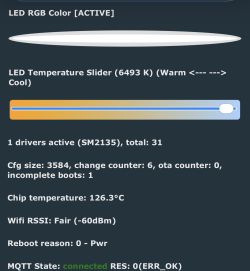I've purchased the cheapest no-name socket I could manage to get. One grim day it failed to power the load, HVAC in particular. So this story started...
As you see, the packaging is absolutely brandless, even no sign of Tuya. Except for the socket, inside there is a small startup guide with a QR code leading to download the standard Tuya Android app.
The socket case has absolutely no marking at all. (Sorry for hot glue, I've already opened it with a Dremel and diamond cutting disc, bastards had the plastic parts welded together, so some plastic had to go)
Sorry, I didn't take any photos from inside, but this is a pretty standard typical socket like this one.
The only thing I remember I didn't like at all is that there is no fuse or any other kind of protection in the power circuit, just a single open relay contact. MCU is a separate CB2S module without a protective screen, soldered at 90 degrees to the main board. Also, on the main board sits a BL0937 and a small switching 3.3v power source.
Since one of the RX1 or TX1 (I don't remember which in particular) is connected on board, I've desoldered it completely to flash OpenBK firmware.
The rest of the process is pretty straightforward and well-documented, I used a CH340 3.3v self-modified UART to USB converter and 115200 baud rate because faster speeds gave errors in the process of verifying when flashing firmware. DIY is typical, cut the 5v trace and solder LM6206N3 in between source 5v, output, and nearby ground:
Pin settings were extracted from Tuya backup firmware while flashing. For this particular socket, they are as follows:
[syntax:json] "pins": {
"6": "BL0937CF1;0",
"7": "BL0937CF;0",
"8": "WifiLED_n;1",
"10": "Btn;1",
"24": "BL0937SEL;0",
"26": "Rel;1"
},[/syntax]
P.S. Now about the fault. This is the relay that was faulty:
I've searched around for a suitable replacement but found nothing due to the miniature size and footprint of this little sucker.
It's probably easier to use the hardware in another project and buy a new socket!
By the way, I personally don't believe it can really stand 20 Amps of load.
So I've got nothing to lose and removed the relay's housing and cleaned its contacts, and voila, it's working again!
That's all, folks!






![[BK7231N/CB2S] Yet Another Noname Smart socket with BL0937 meter [BK7231N/CB2S] Yet Another Noname Smart socket with BL0937 meter](https://obrazki.elektroda.pl/6238704100_1686747396_thumb.jpg)
![[BK7231N/CB2S] Yet Another Noname Smart socket with BL0937 meter [BK7231N/CB2S] Yet Another Noname Smart socket with BL0937 meter](https://obrazki.elektroda.pl/4072451600_1686747429_thumb.jpg)
![[BK7231N/CB2S] Yet Another Noname Smart socket with BL0937 meter [BK7231N/CB2S] Yet Another Noname Smart socket with BL0937 meter](https://obrazki.elektroda.pl/5893956300_1686747441_thumb.jpg)
![[BK7231N/CB2S] Yet Another Noname Smart socket with BL0937 meter [BK7231N/CB2S] Yet Another Noname Smart socket with BL0937 meter](https://obrazki.elektroda.pl/6541842800_1686748147_thumb.jpg)
![[BK7231N/CB2S] Yet Another Noname Smart socket with BL0937 meter [BK7231N/CB2S] Yet Another Noname Smart socket with BL0937 meter](https://obrazki.elektroda.pl/6326980500_1686748169_thumb.jpg)
![[BK7231N/CB2S] Yet Another Noname Smart socket with BL0937 meter [BK7231N/CB2S] Yet Another Noname Smart socket with BL0937 meter](https://obrazki.elektroda.pl/3696587900_1686748183_thumb.jpg)
![[BK7231N/CB2S] Yet Another Noname Smart socket with BL0937 meter [BK7231N/CB2S] Yet Another Noname Smart socket with BL0937 meter](https://obrazki.elektroda.pl/1128932600_1686749233_thumb.jpg)
![[BK7231N/CB2S] Yet Another Noname Smart socket with BL0937 meter [BK7231N/CB2S] Yet Another Noname Smart socket with BL0937 meter](https://obrazki.elektroda.pl/6877962100_1686749584_thumb.jpg)
![[BK7231N/CB2S] Yet Another Noname Smart socket with BL0937 meter [BK7231N/CB2S] Yet Another Noname Smart socket with BL0937 meter](https://obrazki.elektroda.pl/3686811800_1686752003_thumb.jpg)
![[BK7231N/CB2S] Yet Another Noname Smart socket with BL0937 meter [BK7231N/CB2S] Yet Another Noname Smart socket with BL0937 meter](https://static.elektroda.pl/attach/thumb/hz32_datasheet_p3_1393748.jpg)
![[BK7231N/CB2S] Yet Another Noname Smart socket with BL0937 meter [BK7231N/CB2S] Yet Another Noname Smart socket with BL0937 meter](https://static.elektroda.pl/attach/thumb/hz32_datasheet_p2_1003704.jpg)
![[BK7231N/CB2S] Yet Another Noname Smart socket with BL0937 meter [BK7231N/CB2S] Yet Another Noname Smart socket with BL0937 meter](https://static.elektroda.pl/attach/thumb/hz32_datasheet_p1_3435399.jpg)